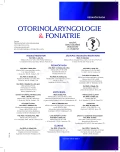-
Medical journals
- Career
Congenital Stridor
Authors: M. Bodláková; M. Jurovčík; R. Katra; J. Skřivan
Authors‘ workplace: Klinika ušní, nosní, krční 2. LF UK a FN Motol, Praha
Published in: Otorinolaryngol Foniatr, 68, 2019, No. 1, pp. 30-35.
Category: Original Article
Overview
Introduction: Congenital stridor is the symptom of many different congenital respiratory diseases with a wide variety of clinical difficulties. Correct and timely diagnostic of the causes of stridor facilitates the recommendation of an adequate therapy. The most common reason for congenital stridor is laryngomalacia.
Objective: The main goal of our research was to evaluate each different clinical unit manifesting by stridor, particularly laryngomalacia, then to document diagnostic procedures and evaluate them relative to procedures used abroad. At the same time alternative options for therapy of stridor were investigated.
Methods: During the time period of 2013 - 2015 the files of 272 patients were reviewed. At the serious stridor or in a case of suspected subglottic stenosis laryngotracheal endoscopy in general anesthesia was indicated directly. Depending on the results of endoscopy either second endoscopy check was recommended or surgery.
Results: In 180 patients the laryngomalacia was the reason of a stridor. In a case of 8 patients with laryngomalacia, a tracheostomy was necessary. For 5 patients, a supraglotoplasty was undertaken. Stridor was also diagnosed in a case of 21 patients with tracheomalacia, 13 patients with laryngotracheomalacia, 26 patients with a subglottic stenosis, 8 patients with a choanal stenosis, 3 patients with a laryngeal web, 5 patients with a laryngeal hemangioma, 7 patients with a recurrent laryngeal nerv paralysis, 5 patients with a laryngotracheal cleft, 4 patients with a laryngeal cyst and 1 patient with an agenesis of epiglottis.
Keywords:
endoscopy – congenital stridor – laryngomalacia
Sources
1. Ada, M., Guvenc, M. G., Yilmaz, S.: Infantile supraglotic hemangioma: a case report. Ear Nose Throat. J., 85, 2006, s. 388-391.
2. Aubry, K. et al.: A case of laryngeal ductal cyst: antenatal diagnosis and peripartum amangement. Int. J: Pediatr. Otorhinolaryngology, 71, 2007, s. 1639-1642.
3. Benjamin, B., Inglis, A.: Minor congenital laryngeal clefts: diagnosis nad clasification. Ann. Otol. Rhinol. Laryngology, 98, 1989,s. 417-420.
4. Benjamin, J. R., Goldberg, R. N., Malcom, W. F.: Neonatal vocal cord paralysis. In Neo Reviews(online), 2009, 10, 10 (cit. 2011-12-08) p.e. 494 - e 501,doi: 10.1542/ neo.10-10-e 494. Dostupné na : http // neoreviews.aappublications.org/content/10/10/e 494.
5. Bolliger, C. T., Probst, R. Tschopp, K., Soler, M.: Silicone endoprothesis in the treatment of tracheobronchial stenosis. Med. Wochenschrift, Schweiz, 121, 1991, s.1283-1288.
6. Boseley, M. E., Hartnick, Ch.: Boston Massachusetts Otolaryngology. Head and Neck Surgery, 135, 2006, s. 318-322.
7. Brown, O. E.: Structure and function of the uppper airway. In Wetmore, R.F., Munttz, H.R., MCGILL, TJ. Pediatric Otolaryngology. New York, Thiem Med. Publ., 2000, s. 686-687.
8. Daya, H. et al.: Pediatric vocal cord paralysis. Along term retrospective study. Arch. Otolaryngol. Head Neck Surgery, 126, 2000, s. 21-25.
9. Doušová T., Pohůnek P.: Stridor,www.prolekare.cz .
10. Dršata, J.: Foniatrie hlas, 2011.
11. Fiala, P., Valenta, J., Eberlová, L.: Stručná anatomie člověka. Karolinum, 2015.
12. Forte, V., Fuoco, G., James, A.: A new classification system for congenital laryngeal cysts. Laryngoskope, 114, 2004, s. 1123-1127.
13. Gysin, C.: Evaluation of the pediatric airway. Rev. Med.Suisse, 2008, 4, 2089-93.
14. Hájek, A., Drábková, J.: Kritická onemocnění průdušnice a jejich léčení. Grada, 2000.
15. Hradský, O. a kol.: Diagnostika a léčba refluxního onemocnění u dětí: Český sjednocený doporučený postup z pohledu gastroenterologa, pneumologa, ORL lékaře, neonatologa a chirurga, Československá pediatrie, 71, 2016, 1, s. 7-12.
16. Hybášek, I..: Ušní, nosní a krční lékařství, 1999, s. 17.
17. Hybášek, J.: eOtorinolarynoglogie, ISSN 1803 - 280x, Verze XI.2015 Laryngologie.
18. Chrobok, V., Astl, J., Komínek, P. a kol.: Trachostomie a koniotomie, techniky, komplikace, ošetřovatelská péče. Maxdorf, 2004.
19. Jakubíková, J.: Vrozené anomálie hlavy a krku. Grada, 2012, s. 79.
20. Jakubíková, J., Pavlovčinová, G., Belicová, J.,: Chirurgická léčba laryngomalacie: ako uchránit novorodzenca a dojča pred tracheostómiou. Pediatria pre prax, 2009, 4, s. 36-37.
21. Kapellerová, A., Dzurenková, A.: Stridor v dětskom veku - pričiny a diagnoza. Pediatria pre prax, 2008, 1, s. 12 - 14.
22. MCSwiney, P. E., Cavanagh, N. P., Languth, P.: Outcome in congenital stridor(laryngomalacia). Arch. Dis. Child.. 52, 1977, s. 215-218.
23. Mornand, A., BarazzoneA. C., Leuchter, I.: Evaluation d´un stridor chez l´enfant www.swiss-paediatric.org.
24. North, P. E. et al.: A unique microvascular phenotype shared by juvenile hemangiomas and human placenta. Arch. Dermatol., 137, 2001, s. 559-570 .
25. Reinhard, A., Sandu, K.: Rev Med Suisse, 2014, s. 1816 - 1819, www.revmed.ch.
26. Sadler, T. W.: Langmanova lékařská embryologie, Grada, 2010, s. 320, 227, 310.
27. Sičák, M.: Rhinológia - choroby nosa a prínosových dutin, 2006, s. 84-111.
28. Silbernagl, S., Lang, F.: Atlas patofyziologie, Grada, 2012, s. 82.
29. Šteffl, M.: Použití stentů a chirurgie při léčbě průdušnicového zúžení, 2005, www.theses.cz .
30. Trojan, S. a kol.: Lékařská fyziologie,Grada, 2004, s. 206-207
31. Wetmore, R. F., Muntz, H. R, McGill, T. J.: Thieme Medical Publishers, New York, 2000.
Labels
Audiology Paediatric ENT ENT (Otorhinolaryngology)
Article was published inOtorhinolaryngology and Phoniatrics

2019 Issue 1-
All articles in this issue
- Lymphatic Malformations of Head and Neck in Children- 10-year Follow-up Results
- Cholesteatoma Behind an Intact Tympanic Membrane – Retrospective Study
- The Brno Cochlear Implant Centre: The Treatment Outcomes of Unilateral Cochlear Implantations in Adults
- The Brno Implant Centre: An Analysis of Cochlear Implant Complications in Adult Patients
- Congenital Stridor
- Descendent Necrotizing Mediastinitis
- Tumor Microenvironment
- Asymmetric Hearing Loss
- Otorhinolaryngology and Phoniatrics
- Journal archive
- Current issue
- Online only
- About the journal
Most read in this issue- Congenital Stridor
- Asymmetric Hearing Loss
- Cholesteatoma Behind an Intact Tympanic Membrane – Retrospective Study
- Tumor Microenvironment
Login#ADS_BOTTOM_SCRIPTS#Forgotten passwordEnter the email address that you registered with. We will send you instructions on how to set a new password.
- Career

